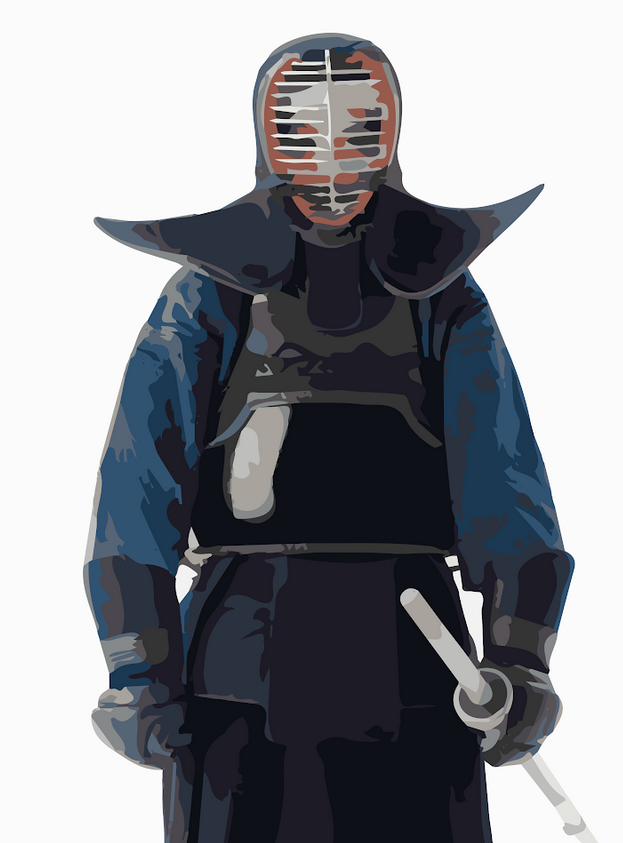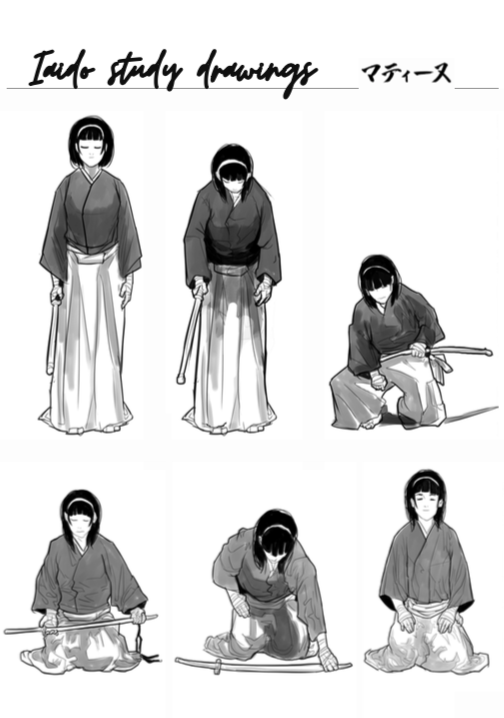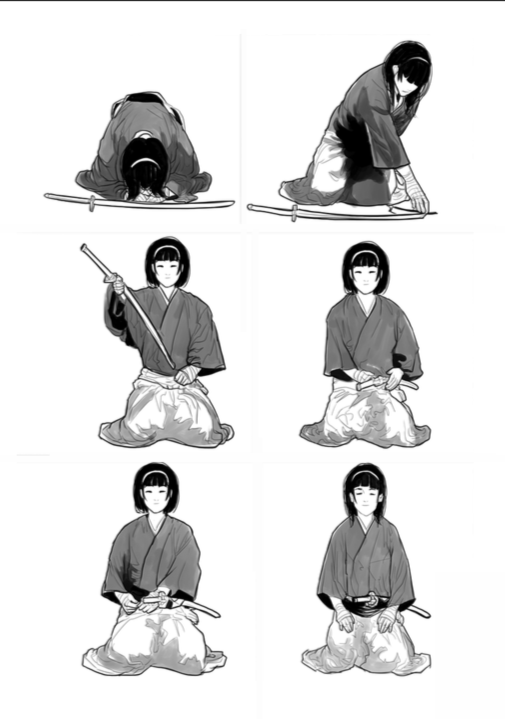Combined motivations in kendo and iaido

In the last issue of Zanshin (2020-2), I wrote about the challenges of continuing your dō in these times of Corona. After its publication, many people reached out to me, mostly with questions on how to keep motivated enough for all these self-directed activities. Therefore, in the following article, I would like to share some more tips on how to keep your (budo) spirits up.
After some information on intrinsic, extrinsic and combined motivations, and some examples of how these work for me, I will further illustrate my methods by sharing a small bibliography on kendo and some new iaido study drawings. But first, I would like to thank every single person that wrote to me – it is always a pleasure to receive your messages, and your questions and comments really help me to improve my thinking and writing.
Intrinsic Motivations
For me, motivation starts within. So, if you are a bit like me in that respect, you’d want to tailor a motivation that resonates with what lives within you, as a stimulus to stay on course. One of the books in my library is called “Find your WHY” (Sinek, 2017). As the title already implies, this rather popular book invites you to question the purpose behind what you’re doing, in order to help you find clarity, meaning, and fulfillment. For me, it is important to search for the bigger picture, the idea of making a contribution to every context in which I am present. In my experience, starting with defining your many purposes in life and working back from there changes everything. If you have some ideas around your purpose, you can start defining your goals by creating a clear compelling vision, and finally make some plans by breaking that vision down into the steps you need to take to reach your goals (and create a realistic agenda planning). Personally, it always helps me to create a visual of my goal, for example by drawing a mindmap, crafting a moodboard and creating self-portraits such as this digital drawing of me in kendōgu.

Extrinsic Motivations
In daily life, there are also external factors that can serve as motivators. People often seem to denigrate them – in favour of the intrinsic motivations – but in my experience, you can put these motivations to good use if you know how they work for you. What often works for me when I feel stuck is to try a fresh approach. I found this, for example, in a new study book for Japanese, that explains the grammar I already learnt (but struggle to remember) from a slightly different angle, with new exercises. Also, it massively helps me to work towards my goals together with other people, as I enjoy the sense of “togetherness” of encouraging each other. Moreover, it feels as if I am accountable to the other people, and their performances inspire me.
A related one is to actively search for inspiring examples to follow, like by listening to the Tokushikai Inside Look podcast of Patrick Suen. To beat procrastination, I like to break my goals into tasks as small as possible – eg for this writing they were: “turn on computer – open new Drive document – create bullet points” etc. – to stay in the zone and get in the flow. The last – but not least – external factor for my motivation is the reward. When I finish a task I do not particularly like, I acknowledge my proud and satisfied feelings by buying myself something nice (like veggies for a healthy meal), taking a warm bath (with salt and pearls), or allowing myself some play time (retro games), afterwards. This prospect is sometimes just the extra push I needed.
Combined Motivations
The easiest way to stay motivated is when you can combine extrinsic and intrinsic motivations. The best example in this category are the “virtual challenges” I joined, thanks to my awesome friend Jolanda. A virtual challenge is a fitness goal that tasks you to walk, run, cycle and/or swim. There can be a certain minimum distance over a specified period of time, but it can also be just “as many miles as you can”. Therefore, anyone of any ability can participate in this competition with yourself, that is challenging yet achievable. You can train when and where it is convenient to you and gradually work towards a bigger goal at your own pace. For me, this really works. It is so much easier to maintain my overall fitness, when it is in an activity “together-apart”, where I can not only earn a shiny medal, but also raise money for charity. Donating to the causes you care about not only benefits the charities themselves, it can be deeply rewarding for yourself as well.
Budo
Let’s see how these concepts translate to budo practise during Covid. By combining motivations, even in these strange times, my karate and kobudo practise went rather smoothly, according to circumstances, as I had the privilege of some (private) lessons and training sessions with my wonderful sensei, both virtually and in the dojo. Moreover, the shutdown over Covid presented me with an opportunity, which I grabbed with both hands; the advent of online Kata Tournaments. In these tournaments, competitors from all over the world compete against each other in a one on one knockout style competition, but all is completely virtual, so I performed some of my favourite kata in front of my phone or webcam. So far, I have achieved one 3rd place and two 2nd places, and am currently preparing for the semi final round of the Euro Grand Prix e-tournament. It is always very instructive to have to perform kata on the spot (sometimes just from my own home) and rewatch them (and cringe), to look at the performances of the other participants and to listen to the comments I received (mostly from the jury, but also from the other participants and their coaches). For kendo and iaido, however, this was a completely different story. I could hardly train those disciplines outside of my home, so I had to adjust my routines – I mean, it is rather impossible to practise kirikaeshi when you are in your apartment, alone, isn’t it? Still, even in lockdown, I found that there are many ways to engage with your budo today, to become a better budoka tomorrow.
Kendo
For kendo, I first examined my “why”, my intrinsic motivations. And I found that I wish to learn (about) kendo for three reasons. One: I desire to gain a better understanding of Japanese sword culture and history. Two: I aim to become better at kendo and enjoy this practise. Three: I want to understand and remember kendo jargon and related Japanese terms in order to pass the theoretical part of my first Dan exam. My favourite book about queries in the first category remains The Book of Five Rings, by Miyamoto Musashi kensei, who is also a great example for me in the fine arts (sumi-e, calligraphy and self-portrayal). As for my second and third wish, luckily, I found that there are a plethora of books and manuals published to aid people like me in meeting these needs.
Various inspiring kendo practitioners have poured their wisdom, knowledge and experiences in books with the intention of making kendo training, philosophy and history more effective and accessible to learners. Thanks to the present-day technologies, many of these books are now also available online. In the next section, “from the library of a kendoka”, you’ll find a small bibliography containing five interesting books on kendo. This selection is rather random, often based on availability and price, but I learnt something new from each of them. Other honorable mentions include; Teikoku Kendo Kyohon (The Kendo Textbook of Imperial Japan) by Ogawa Kinnosuke, (Self-published, 2015), Kendo Tokukon (The Kendo Reader) by Noma Hisashi (Self-published, 2013), and This is Kendo: The Art of Japanese Fencing by Junzo Sasamori and Gordon Warner (Tuttle Publishing, 2012). Should your favourite kendo book be missing from this list, please do not hesitate to inform me about it.
Iaido
In iai, my way forward at the moment lies mainly in memorising the kata. Even if I cannot physically train (with my iaito), I try to practice this mentally, by imagining myself performing the kata, and studying the ZNKR booklet. To remember the sequences and try to see the various body movements as a whole, without mixing the various kata up, I regularly sketch some of the distinct postures through which the motions pass. As many people asked me to share more of my study drawings, I inked a series about the to rei. Once more, I would like to explicitly mention that this is not meant as an example of the “right” form, but as an example of how you can work on your iaido from behind your desk, in order to better remember the sequence of actions (just like reading/writing the booklet). Although Franz Liszt is claimed to have given concerts with pieces he had only mentally practised, in my opinion, mental practice will never replace physical training, but it might be a nice addition and a way to keep up your level as well as your motivation.


0 Comments on “Combined motivations in kendo and iaido”